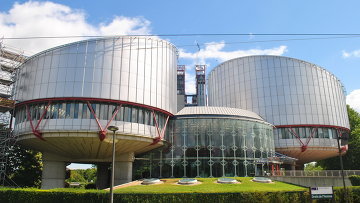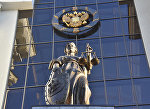MOSCOW, March 14 – RAPSI, Ingrid Burke. The European Court of Human Rights (ECHR) held Thursday that Russia did not violate the rights of members of an extremist Muslim organization to freedom or religion, expression, or peaceful assembly by convicting them of membership in a terrorist organization.
The judgment further cleared Russia of charges that it had violated the rights of one applicant by prosecuting him before an official list of terrorist organizations including his own was published, but held Russia to account on this charge for the second claimant.
The case centers on Yusup Kasymakhunov and Marat Saybatalov, two members of Hizb ut-Tahrir, a religious group classified in Russia as a terrorist organization.
In 2003, The Russian Supreme Court designated Hizb ut-Tahrir as a terrorist organization and prohibited its activity in Russia. The list of banned terrorist organizations including Hizb ut-Tahrir was not featured in the official state publication Rossiskaya Gazeta until 2006. Both applicants were arrested in 2004. Both complained that they had not known at the time of their involvement in the organization that such had constituted criminal activity, as the list had not yet been published.
Both men invoke the protection of Article 7 of the European Convention on Human Rights (Convention) which states: “No one shall be held guilty of any criminal offence on account of any act or omission which did not constitute a criminal offence under national or international law at the time when it was committed,” but stipulates that, “This article shall not prejudice the trial and punishment of any person for any act or omission which, at the time when it was committed, was criminal according to the general principles of law recognised by civilised nations.”
Details on the Organization
The judgment refers to the group at the center of this case as follows: “an international Islamic organisation with branches in many parts of the world, including the Middle East and Europe. It advocates the overthrow of governments and their replacement by an Islamic State in the form of a recreated Caliphate.”
The judgment cited reports released by various research and advocacy groups, including world renowned crisis think tank the International Crisis Group (ICG) as well as famed international human rights organization Human Rights Watch (HRW) in order to flesh out its understanding of the shadowy organization.
According to ICG’s 2003 report, Hizb ut-Tahrir is a political organization whose aim is to unite all Muslims via the establishment of one massive state capable of counterbalancing the West. Such Islamic powerhouses as Saudi Arabia and Iran have fallen short of Hizb ut-Tahrir’s goal: “According to Hizb ut-Tahrir, the Islamic state is one in which Islamic law – Sharia – is applied to all walks of life, and there is no compromise with other forms of legislation.”
While the organization nominally disavows terrorism, the ICG explains that its rhetoric can be seen as justifying violence: “In theory, the group rejects terrorism, considering the killing of innocents to be against Islamic law. However, behind this rhetoric, there is some ideological justification for violence in its literature, and it admits participation in a number of failed coup attempts in the Middle East.”
The report describes the group’s idea of political struggle in three stages:
1. Recruiting and “culturing” interested members
2. Interaction with the greater Muslim community
3. “The stage of taking the government and implementing Islam completely and totally, and carrying its message to the world.”
The section of the report included in the judgment concludes that the group itself should not be classified as terrorist in its own right, but warned that Hizb ut-Tahrir “is willing to persuade militaries to overthrow their governments, and in certain cases be involved in such military coups itself.”
A similarly damning report was issued by HRW in 2004, describing the organization as one that renounces violence, but one that “does not reject the use of violence during armed conflicts already under way and in which the group regards Muslims as struggling against oppressors, such as Palestinian violence against Israeli occupation.”
Still, the report states that the fact that the group is widely considered to be of a political rather than religious nature should not undermine the rights of its members to be protected from religious persecution: “religion and politics are inseparable in Hizb ut-Tahrir’s ideology and activities.”
The portion of the report included concludes however that the organization believes that the only way to legitimately establish the Muslim state it aspires toward is through a gradual “awakening” among Muslims.
Another report released by European think tank Transnational Terrorism, Security, and the Rule of Law (TTSRL) explains that Hizb ut-Tahrir is “very smart in walking the very fine line between propaganda and incitement to terrorism,” quoting Paul Wilkinson, Director of the UK’s Centre for the Study of Terrorism and Political Violence at the University of St. Andrews.
Hizb ut-Tahrir Literature
The judgment explores various elements of Hizb ut-Tahrir literature, including a draft constitution which stipulates that those found guilty of apostasy from Islam should be “executed according to the rule of apostasy, provided they have by themselves renounced Islam.”
The draft constitution would ban diplomacy as a whole, stating: “It is absolutely forbidden for any individual, party, group or association to have relations with a foreign state...”
Delaying the Publication of the list of Terrorist Organizations
The Russian government admitted to having failed to publish the list of terrorist organizations for more than three years after the Hizb ut-Tahrir ruling. This was due, however, to a lack of existing protocol for the publication of such a list. The protocol was established in March 2006, just a few months shy of the list’s publication.
The government pointed to the fact that news of the ruling was widely disseminated through popular media, and to the fact that ignorance does not serve as a valid excuse for breaking the law.
The ECHR’S Take on Things
The ECHR considered the 2006 publication of the list of terrorist organizations, as well as an array of Russian law, including various articles of the Criminal Code, the Anti-Terrorism Act (1998), and the Suppression of Extremism Act (2002).
In considering whether Russia violated Article 7 in prosecuting the two applicants, the ECHR considered the extent to which proceedings against each centered on the Supreme Court judgment as opposed to other, pre-existing elements of Russian law.
In the case of Kasymakhunov, the court held that while the Russian court did rely on the Supreme Court decision, its decision was based largely on an analysis of Hizb ut-Tahrir leaflets and brochures that called for violent coup d’etats and “glorified warfare against non-Muslim States.” The court considered such evidence as the inclusion in these pamphlets of information on using weapons, explosives, and poisons in crafting its decision on the groups terroristic leanings. Thus the ECHR held that the Supreme Court opinion did not prove an essential enough element to justify the existence of an Article 7 violation in Kasymakhunov’s case.
On the other hand, the ECHR held that Russia had violated Article 7 in the case of Saybatalov, who had been convicted in part on the basis of “founding and membership of an extremist organization.” This particular article under the Russian Criminal Code stipulates that in order to qualify, an organization must have been deemed extremist by a court decision. Thus the Supreme Court decision was key to the court’s determination of Saybatalov’s guilt.
While noting Russia’s explanation of the fact that Saybatalov knew Hizb ut-Tahrir had been categorized as a terrorist organization, the ECHR held that widespread press coverage alone wasn’t sufficient in this case, holding: “Only a publication emanating from an official source can give an adequate and reliable indication of the legal rules applicable in a given case.”
Freedoms of Religion, Expression, and Peaceful Assembly
The claimants further alleged that their freedoms of religion, expression, and peaceful assembly had been violated, citing Articles 9, 10, and 11 of the Convention respectively.
To this, the ECHR cited Article 17 of the Convention, which states that: “Nothing in [the] Convention may be interpreted as implying for any state, group or person any right to engage in any activity or perform any act aimed at the destruction of any of the rights and freedoms set forth herein or at their limitation to a greater extent than is provided for in the Convention.”
The court explored the organization’s aims, finding no shortage of threats to the rights and freedoms of others. Specific examples of this included evidence that the organization had called for violence against Jews, and the inclusion in its Constitution of a rule that all apostates should be executed. The fact that its ideal state would be based on Sharia Law further proved problematic in the ECHR’s view in connection with democracy, criminal law, and women’s rights.



